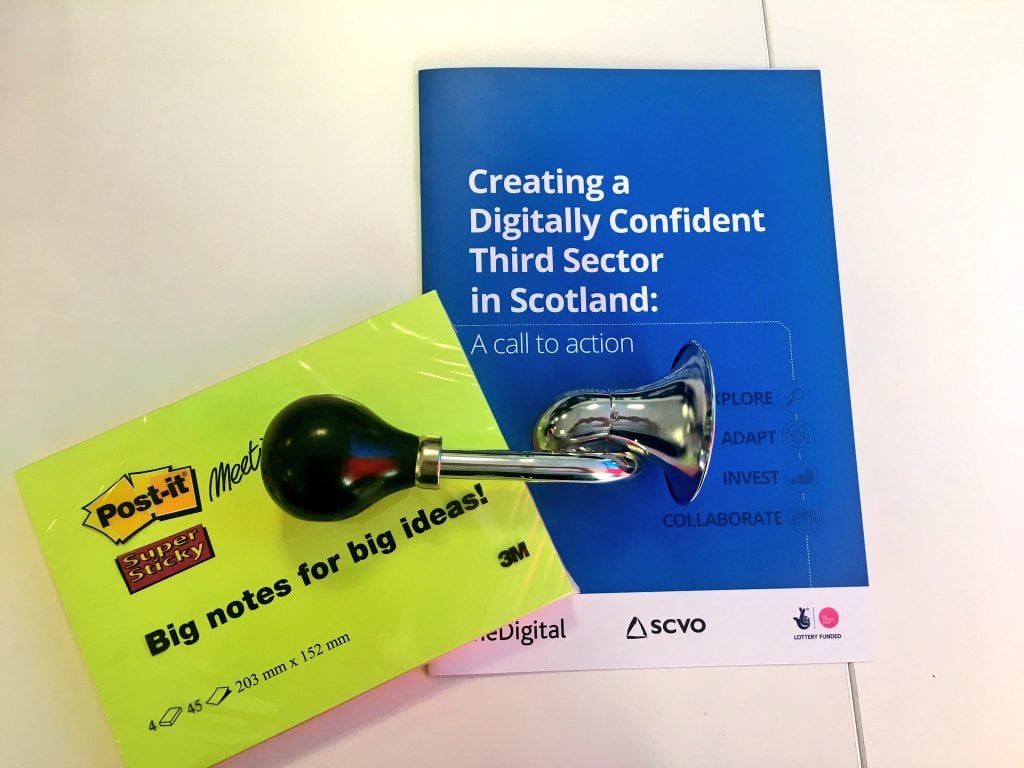Digital
Scotland’s Digital Strategy and the third sector
June 2, 2017 by Stewart Hamilton No Comments | Category Digital Participation, Uncategorized
This is a guest post from David McNeill, Digital Director at the Scottish Council for Voluntary Organisations, on what the refreshed digital strategy means for the third sector.
The first in a series of posts from Chief Digital Officers in different sectors.
Realising Scotland’s full potential in a Digital World sets out the Scottish Government’s vision for how citizens, organisations, businesses and public services can maximise the opportunities and minimise the risks of new technology and the internet. What does the strategy mean for the third sector over the next few years?
Leaving no-one behind
While many of us take the ability to use the internet for granted, the latest statistics show that one-in-ten people have never used the internet. However, more than double that figure lack the basic digital skills to be able to benefit fully from the internet.
A starting point for truly realising Scotland’s full potential must be in ensuring that no-one is left behind in a digital world. That’s why the Government will continue to ask organisations across all sectors to commit to building the confidence and skills of their workforce and communities through the Digital Participation Charter. This is particularly important for the third sector, as they are likely to already be supporting people who are digitally excluded, particularly those who are older, have a disability or are on low incomes.
Building on the success of the 127 community projects that have reached over 15,000 people, the Scottish Government will continue to invest in local projects to help build digital confidence and skills, as well as reducing the barriers to access.
There is also a commitment to removing the barriers to access in our rural communities, with action planned to achieve 100% superfast broadband coverage by 2021.
Building a fairer internet
Protecting the rights of individuals is at the heart of what many third sector organisations do. The Strategy commits to stimulate a public debate on rights and responsibilities in a digital age, as well as reviewing how automation and digitisation will impact on the future of work.
Young Scot have been leading the way on this by supporting a group of young people to explore how their rights should be respected in an online world, enabling them to access the internet creatively, knowledgeably and fearlessly. If you are an organisation delivering a service online, it’s important to consider whether you respect the 5Rights. If you do, you’re probably well on your way to being compliant with the forthcoming EU General Data Protection Regulation too!
Designing public services around the needs of users
It’s long been known that services build with people are more successful than those built for people. The Strategy commits to designing digital public services around the needs of their users. The Digital First Service Standard provides a great guide for organisations to follow in developing their own services, with co-production at the centre.
The strategy notes that digital health and care services are likely to be transformed through the use of new technology:
“Benefits include the ability to manage your own care, have a video consultation or be supported in your own home by a care worker who can use mobile technology to access the data and records they need. This provides the opportunity to use remote monitoring to track your health condition and anticipate problems at the earliest possible stage.”
With 38% of Scotland’s third sector organisations involved in the delivery of health and social care, with a combined economic contribution of over £1.6bn, many will need to redesign their services for a digital world. Some, such as Blackwood and Carr Gomm, are already investing in innovative new services that maximise the potential of new technology to deliver better outcomes, more efficiently.
Developing the future workforce
If Scotland is to have excellent digital public services, digitally confident organisations and a strong digital businesses, there is a need to tackle the high-level digital skills shortage. A range of actions are set out in the Strategy for the formal education sector, but extra-curricular activities are also crucial. Hundreds of volunteers are already supporting children and young people to develop their interest in STEM subjects and the Digital Xtra Fund, now an independent charity, is stimulating the development of coding clubs across the country. This work can also contribute towards Scotland build a more diverse digital workforce.
Being safe and secure online
We also need to ensure we minimise the risks of operating in a digital world. Cyber resilience has perhaps been something that’s been perceived as an issue for ‘IT people’. However, keeping safe online is everyone’s business and the recent coverage of the worldwide ransomware attack highlights the importance of this. Third sector organisations should consider whether they have adequate controls to defend against cyber attacks and are confident in their ability to recover quickly should the worst happen.
Maximising the opportunities
These are just a few of the connections to Scotland’s Digital Strategy for the third sector. There is a range of other work going on across the sector which will help Scotland realise its full potential in a digital world, from:
- Increasing participation and engagement in the democratic process – such as the Democratic Society’s work on digital tools and participatory budgeting
- Using open data to support innovation – such as 360 Giving aggregating data on grant awards
- Shared digital platforms – such as Milo, which includes the national volunteer opportunities database
To keep up-to-date on all things related to digital in Scotland’s third sector, please visit the SCVO digital team online or follow us on Twitter.
Tags: digital strategy, guest blog, scvo, third sector


Leave a comment